-
0:00/4:12
-
Fake 2:590:00/2:59
-
0:00/1:03
-
0:00/5:32
-
Leading Me Astray 6:580:00/6:58
-
0:00/5:32
-
Fracture 3:040:00/3:04
-
Scalpel 6:250:00/6:25
-
0:00/1:11
-
Whole 7:360:00/7:36
-
Wrecker Music 0:490:00/0:49
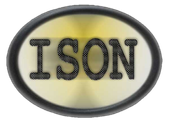
EQ
Equalization is the most important and frequently used tool when working with sound.
A great EQ allows you to carve out a clear and defined tonal space for each instrument so that sounds combine without cluttering up the mix.
A great EQ should allow the user to bring out the special qualities of sounds while at the same time, reducing their less favorable aspects.
And probably most importantly, a great eq should also impart a certain sheen to a mix when wanted.
With sizzling highs and thundering low end punch, the De-Vice' ISON achieves all this and brings previously unknown flexibility and tonal shaping possibilities to Creamware's Scope.
There is no comparison with standard EQs.

Coloured 'Ghost curves' show exactly what each band is doing while the main yellow curve shows the resultant EQ curve.
Why do all EQ's sound different?
How an eq sounds is determined to a large degree by the interaction between the controls.
In a normal digital EQ, as you boost or cut a frequency (Gain), the Q (quality or bandwidth) that you set remains constant no matter how much you boost or cut.
This style of eq is referred to as having a 'Constant Q' whereas, in a typical analog circuit, precision of that type is very difficult to produce. In an analog eq, when a frequency is boosted or cut, the bandwidth or Q amount varies due to limitations in the circuit and components through which the signal passes. This constant circuit interaction called 'Q/Gain dependency' results in analog eqs having a different functional and tonal character than digital EQs.
These inherent flaws in analog processing are what actually determine the analog EQ's sound and lead people to label it with words like 'warm', 'smooth' and 'transparent'.

dynamic D.S.P switching reduces DSP load

|
Through 5 stages of EQ with 24dB of boost and cut per band and low and high pass 48dB per octave filters, you can be as subtle or extreme as you like. The highest and lowest bands of the ISON are switchable to shelving, allowing broad sweeping boosts and cuts to add sparkle and low end enhancement. A large high resolution graphic EQ curve shows you what's happening.
|


![]()
Surface controls are switchable between knobs or faders...we couldn't decide!
As early research into EQ has shown, an important consideration with shelving eq is what happens in the frequency range just below and above the point where the boost and cut in the shelving EQ is occurring. Say, you want to add some sparkle to the top end of a mix but don't want to boost the mid range. This 'overshoot' and 'undershoot' is crucial in reducing the midrange 'honkiness' and low range 'mudiness' often associated with digital, non-interactive shelving EQs.



The low and high-shelf switches have overshoot and undershoot switches.
The ISON eq gives you total control over these problem areas with adjustable 'overshoot' and 'undershoot' for both the high and low shelving sections of the highest and lowest frequency bands. When switched to shelf, the Q control acts as the 'overshoot' and 'undershoot' adjustment allowing the steepness and shape of the shelving curve to be manipulated. In addition, we give you upper and lower lip peak and dip switches to expand the range of creative possibilities.
Decramping is another feature which helps to improve clarity and warmth in the top and bottom ends of the frequency spectrum. You can adjust this and other special features at anytime during the mix from the SETUP page of the plug-in's interface and all settings can be stored as part of the preset list.

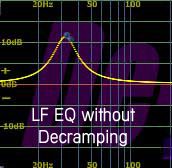
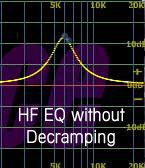
Normal digital EQs can sound harsh as the ultra high and low ends are consequently squashed back down to zero during EQ'ing. Our EQ simulates this style of digital EQ when the decramping switches on the SETUP page are switched to 'none'.
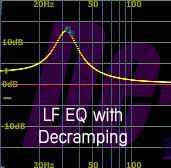
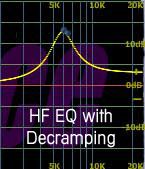
The decramping feature of the ISON reduces the constriction of these highest and lowest frequency areas and effectively adds 'air' and bottom end presence to the sound as in an analog EQ design.
FILTERS FROM HEAVEN!
How could we forget to mention the filters!?
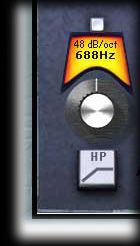

The high and low pass filters are switchable in 6dB steps from 6dB to 48dB per octave and are incredibly severe at 48dB! Use them to gently roll-off the high end to reduce hiss on a drum tape track or eliminate DC offset and rumble from problem sounds.

The sweep control allows you to sweep the normally unlinked HP&LP filters through their entire frequency range from 0=>24KHZ for dramatic filtering effects.
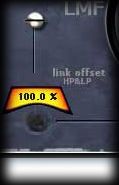
This link offset fader widens the gap between the linked HP&LP controls and allows a broader band of frequency to be swept.
F E A T U R E S
![]() 7 stages of precision EQ with 24dB of boost and cut per band
7 stages of precision EQ with 24dB of boost and cut per band![]()
![]() Dynamic DSP management so bypass stages use no DSP load!
Dynamic DSP management so bypass stages use no DSP load!![]()
![]() high and low bands switchable to shelf EQ with variable overshoot and undershoot controls
high and low bands switchable to shelf EQ with variable overshoot and undershoot controls![]()
![]() additional high and low pass filter sections switchable in 6dB per octave steps to 48dB
additional high and low pass filter sections switchable in 6dB per octave steps to 48dB![]()
![]() Q/Gain dependency to simulate a broad range of analog and digital EQ styles
Q/Gain dependency to simulate a broad range of analog and digital EQ styles![]()
![]() 6 switchable styles of EQ for maximum artistic flexibility
6 switchable styles of EQ for maximum artistic flexibility![]()
![]() high and low frequency decramped curves for sonic clarity
high and low frequency decramped curves for sonic clarity![]()
![]() Large eq display with Ghost EQ curves showing individual frequency ranges
Large eq display with Ghost EQ curves showing individual frequency ranges![]()
![]() Controls switchable between knobs and faders...we couldn't decide!
Controls switchable between knobs and faders...we couldn't decide!![]()
![]() Stereo and mono, project window and mixer insert compatible
Stereo and mono, project window and mixer insert compatible![]()
![]() Single, multiple and filter only versions included for reduced DSP load
Single, multiple and filter only versions included for reduced DSP load![]()
![]() Compare function for easy A/B'ing between two settings
Compare function for easy A/B'ing between two settings![]()
![]() Full MIDI control
Full MIDI control![]()
